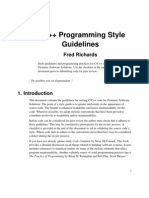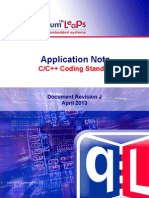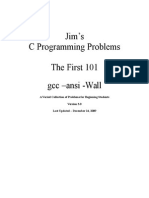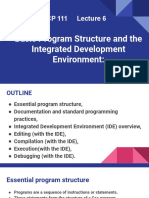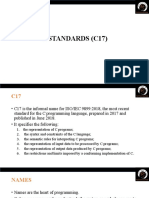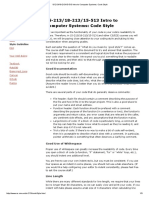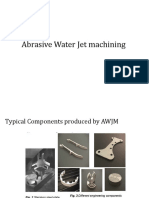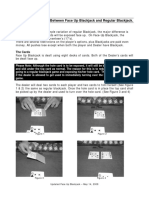Epitech Documentation
C Coding Style
Keep your code nice and clean
4.0
�The Epitech Coding Style is a set of rules, guidelines and programming conventions that has been created
within the school, and that you have to respect.
It applies to:
• the organization of the delivery folder,
• the denomination of the identifiers,
• the overall presentation (paragraphs),
• the local presentation (lines),
• source files and headers,
• Makefiles.
The Coding Style is a purely syntactic convention, so it can not be used as an excuse if
your program does not work!
It is compulsory on all programs written in C as part of Epitech projects, regardless of the year or unit.
It applies to all source files (.c) and headers (.h), as well as Makefiles.
Although the Coding Style is not required in all projects, this is not a reason for not always
sequencing and structuring your code!
Most of the rules in this Coding Style apply to all languages, so it can be useful when
you’re doing projects in different languages.
It’s easier and quicker to follow the guide style from the beginning of a project rather
than to adapt an existing code at the end.
The existence of this Coding Style is justified by the need to standardize the writing of programs within the
school, in order to facilitate group work.
It is also an excellent way to encourage structuring and clarity of the code and thus facilitate :
• its reading,
• its debugging,
• its maintenance,
• its internal logic,
• its reuse,
• writing tests,
• adding new features . . .
When you are facing a choice and you do not know what decision to make, always ask
yourself which one helps to make your code clearer, ergonomic and flexible.
1
�However, if you provide a complete, relevant, accurate justification with a long-term view (cleanliness,
legibility, code flexibility, optimization, etc.), you can infringe some of the Coding Style points.
The relevance of this justification is left to the discretion of the proofreader, so it is prefer-
able to present a strong argumentation or to abstain.
In case of uncertainty or ambiguity in the principles specified in this document refer to your local education
manager.
There are 3 levels of severity: major , minor and info .
There are many and many ways to produce unclean code.
Even though one cannot mention all of them in this document, they have to be respected.
We call them implicite rules when not explicitly defined in this document.
Implicit rules are considered as infos .
This document is inspired by the Linux Kernel Coding Style , and is freely adapted from
Robert C. Martin’s excellent book Clean Code.
Some tools (such as Editor Config) might simplify the task.
2
�O - FILES ORGANIZATION
O1 - CONTENTS OF THE DELIVERY FOLDER
The delivery folder should not contain compiled (.o, .gch, .a, .so, . . . ), temporary or unnecessary files
(*~ * #, *.d, toto,. . . ).).
O2 - FILE EXTENSION
Sources in a C program should only have .c or .h extensions.
O3 - FILE COHERENCE
A source file should match a logical entity, and group all the functions associated with that entity.
Grouping functions that are not related to each other in the same file has to be avoided.
Beyond 5 functions in your file, you should probably subdivide your logical entity into
several sub-entities.
O4 - NAMING FILES AND FOLDERS
The name of the file should define the logical entity it represents, and thus be clear, precise, explicit and
unambiguous.
For example, the string.c or algo.c files are probably incorrectly named.
Names like string_toolbox.c or pathfinding.c would be more appropriate.
All file names and folders should be in English, according to the snake_case convention (that is, composed
only of lowercase, numbers, and underscores).
Abbreviations are tolerated to the extent that they can significantly reduce the size of
the name without losing the meaning.
3
�G - GLOBAL SCOPE
G1 - FILE HEADER
The source files (.c,.h, Makefile,. . . ) should always start with the standard header of the school.
This header is created in Emacs using the C-c C-h command.
For C files:
/*
** EPITECH PROJECT , $YEAR
** $ N A M E _ O F _ THE_PROJECT
** File description :
** No file there , just an epitech header example
*/
For Makefiles:
##
## EPITECH PROJECT , $YEAR
## $ N A M E _ O F _ THE_PROJECT
## File description :
## No file there , just an epitech header example
##
G2 - SEPARATION OF FUNCTIONS
Inside a source file, one and only one empty line should separate the implementations of functions.
G3 - INDENTATION OF PREPROCESSOR DIRECTIVES
The preprocessor directives should be indented according to the level of indirection.
Indentation must be done in the same way as in the L2 rule (groups of 4 spaces, no
tabulations). However, preprocessor directives must be indented independently of all
the other code.
# ifndef WIN32
# if defined ( __i386__ ) || defined ( __x86_64__ )
const size_t PAGE_SIZE = 4096;
# else
# error " Unknown architecture "
# endif
struct coords {
int x ;
int y ;
};
# endif
4
� G4 - GLOBAL VARIABLES
Global variables should be avoided as much as possible.
Only global constants should be used.
A constant is considered as such if and only if it is correctly marked with the const key-
word. Watch out, this keyword follows some particular and sometimes surprising rules!
const float GOLDEN_RATIO = 1.61803398875; /* OK */
int uptime = 0; /* G4 violation */
G5 - STATIC
Global variables and functions that are not used outside the compilation unit to which they belong should
be marked with the static keyword.
Be careful not to confuse the different uses of the static keyword.
G6 - INCLUDE
Include directive should only include header .h files.
G7 - LINE ENDINGS
Line endings must be done in UNIX style (with \n).
\r must not be used at all, anywhere in the files.
G8 - TRAILING SPACES
No trailing spaces must be present at the end of a line.
5
� G9 - LEADING/TRAILING LINES
No leading empty lines must be present.
No more than 1 trailing empty line must be present.
G10 - CONSTANT VALUES
Non-trivial constant values should be defined either as a global constant or as a macro.
6
�F - FUNCTIONS
F1 - COHERENCE OF FUNCTIONS
A function should only do one thing, not mix the different levels of abstraction and respect the principle
of single responsibility (a function must only be changed for one reason).
For example, a call to malloc(), a call to allocate_user() and a call to create_user() have
3 different levels of abstraction.
F2 - NAMING FUNCTIONS
The name of a function should define the task it executes and should contain a verb.
For example, the voyals_nb() and dijkstra() functions are incorrectly named.
get_voyals_number() and search_shortest_path() are more meaningful and precise.
All function names should be in English, according to the snake_case convention (meaning that it is com-
posed only of lowercase, numbers, and underscores).
Abbreviations are tolerated if they significantly reduce the name without losing mean-
ing.
F3 - NUMBER OF COLUMNS
The length of a line should not exceed 80 columns (not to be confused with 80 characters!).
A tab represents 1 character, but several columns.
Even though this rule especially applies to functions, it applies to all C files, as
well as Makefiles.
7
� F4 - NUMBER OF LINES
The body of a function should be as short as possible.
If the body of a function exceeds 20 lines, it probably does too many tasks!
int main ( void ) /* this function is 2 - line - long */
{
printf ( " hello , world \ n " ) ;
return (0) ;
}
The maximum length of a function is inversely proportional to the complexity and indentation level of
that function. case-statement , where you have lots of small things for a lot of different cases, it’s OK to
have a longer function.
Linus Torvalds, Linux Kernel Coding Style
F5 - ARGUMENTS
The statement of arguments should be in accordance to the ISO/ANSI C syntax.
A function taking no parameters should take void as argument in the function declaration.
phys_addr_t alloc_frame () ; /* F5 violation */
phys_addr_t alloc_frame ( void ) ; /* OK */
A function should not need more than 4 arguments.
Writing variadic functions is allowed, but they should not be used to circumvent the limit of 4 parameters.
Structures should be transmitted as parameters using a pointer, not by copy.
void make_some_coffee ( struct my_struct * board , int i ) /* OK */
{
do_something () ;
}
8
� F6 - COMMENTS INSIDE A FUNCTION
There should be no comment within a function.
The function should be readable and self-explanatory, without further need for explanations.
The length of a function being inversely proportional to its complexity, a complicated
function should be short ; so a header comment should be enough to explain it.
F7 - NESTED FUNCTIONS
Nested functions are an extension of the GNU C standard which is not allowed because it increase com-
plexity.
9
�L - LAYOUT INSIDE A FUNCTION SCOPE
L1 - CODE LINE CONTENT
A line should correspond to only one statement.
Typical situations to avoid are:
• several assignments on the same line,
• several semi-colons on the same line, used to separate several code sequences,
• a condition and an assignment on the same line.
a = b = c = 0; /* L1 violation */
a ++; b ++; /* L1 violation */
if (( ptr = malloc ( sizeof ( struct my_struct ) ) ) != NULL ) /* L1 violation */
if ( cond ) return ( ptr ) ; /* L1 violation */
a = do_something () , 5; /* L1 violation */
L2 - INDENTATION
Each indentation level must be done by using 4 spaces.
No tabulations may be used for indentation.
When entering a new scope (e.g.: control structure), the indentation level must be incremented.
// OK
int main () {
char letter = 'H ';
int number = 14;
if ( letter == 'H ') {
my_putchar ( 'U ') ;
} else if ( letter == 'G ') {
if ( number != 10)
my_putchar ( 'O ') ;
else {
my_putnbr (97) ;
}
}
}
// Incorrect
int main () {
int i ;
}
// Incorrect
int main () {
if ( true )
return (0) ;
}
10
�// Incorrect and ugly
int main () {
char letter = 'H ';
int number = 14;
if ( letter == 'H ') {
my_putchar ( 'U ') ;
} else if ( letter == 'G ') {
if ( number != 10) {
my_putchar ( 'O ') ;
} else {
my_putnbr (97) ;
}
}
}
L3 - SPACES
When using a space as a separator, one and only one space character must be used.
Tabs cannot be used as a separator.
Always place a space after a comma or a keyword (if it has arguments).
However, there must be no spaces between the name of a function and the opening parenthesis, after a
unary operator, or before a semicolon.
If the precise case of a for control structure, if a semicolon inside the parentheses is not immediately fol-
lowed by another semicolon, it must be followed by a space.
All binary and ternary operators should be separated from their arguments by a space on both sides.
return is a keyword but sizeof is a unary operator!
return (1) ; /* L3 violation */
return (1) ; /* OK */
return 1; /* OK */
return (1 + 2) ; /* L3 violation */
break ; /* OK */
break ; /* L3 violation */
sum = term1 + 2 * term2 ; /* OK */
s = sizeof ( struct file ) ; /* OK */
11
� L4 - CURLY BRACKETS
Opening curly brackets should be at the end of their line, except for functions where they must be placed
alone on their line.
Closing curly brackets should always be alone on their line, except in the case of else/else if statements,
enum declarations, or structure declarations (with or without a typedef).
In the case of a single-line scope, curly brackets are optional.
if ( cond ) { return ( ptr ) ;} /* L1 & L4 violation */
while ( cond ) { /* OK */
do_something () ;
}
if ( cond ) /* L4 violation */
{
...
} else { /* OK */
...
}
if ( cond ) /* OK */
return ( ptr ) ;
int print_env ( void ) /* OK */
{
...
}
int print_env ( void ) { /* L4 violation */
...
}
Even though this primarily applies to the contents of functions, this rule also applies to
code outside functions, including header files’.
12
� L5 - VARIABLE DECLARATION
Variables should be declared at the beginning of the scope of the function.
The for-loop counters may optionally be declared within the loop.
Nothing prevents you from declaring and assigning a variable on the same line.
Only one variable should be declared per line.
long calculate_gcd ( long a , long b )
{
long biggest , smallest ; /* L5 violation */
biggest = MAX (a , b ) ;
smallest = MIN (a , b ) ;
long rest ; /* L5 violation */
while ( smallest > 0) {
rest = biggest % smallest ;
biggest = smallest ;
smallest = rest ;
}
return ( a ) ;
}
13
�int main ( void )
{
int forty_two = 42; /* OK */
int max = 12; /* OK */
for ( int i = 0; i < max ; i ++) /* OK */
calculate_pgcd ( forty_two , max ) ;
return (0) ;
}
L6 - LINE JUMPS
A line break should separate the variable declarations from the remainder of the function.
No other line breaks should be present in the scope of a function.
int sys_open ( char const * path )
{
int fd = thread_reserve_fd () ;
struct filehandler * fhandler = NULL ;
/* OK */
if ( fd < 0)
return ( -1) ;
if ( fs_open ( path , & fhandler ) ) {
thread_free_fd ( fd ) ;
return ( -1) ;
}
/* L6 violation */
t h r e a d _ s et_ fd_ha ndle r ( fd , fhandler ) ;
return ( fd ) ;
}
V - VARIABLES AND TYPES
V1 - NAMING IDENTIFIERS
All identifier names should be in English, according to the snake_case convention (meaning it is composed
exclusively of lowercase, numbers, and underscores).
Abbreviations are tolerated as long as they significantly reduce the name length without
losing meaning.
The type names defined with typedef should end with _t.
The names of macros and global constants and the content of enums should be written in UPPER_CASE.
14
�# define IS_PAGE_ALIGNED ( x ) (!(( x ) & ( PAGE_SIZE - 1) ) ) /* OK */
enum arch { /* OK */
I386 = 0 ,
X86_64 ,
ARM ,
ARM64 ,
SPARC ,
POWERPC ,
};
const float PI = 3.14159; /* OK */
typedef int age ; /* V1 violation */
typedef struct int_couple pixel_t ; /* OK */
V2 - STRUCTURES
Variables could be grouped together into a structure if and only if they form a coherent entity.
Structures must be kept as small as possible.
struct person { /* OK */
char * name ;
unsigned int age ;
float salary ;
};
struct trashy { /* V2 violation */
struct person player ;
unsigned int width ;
unsigned int length ;
unsigned int score ;
int i ;
};
V3 - POINTERS
The pointer symbol (*) should be attached to the associated variable, with no spaces.
This rule applies only in the pointer context.
int * a ; /* V3 violation */
int * a ; /* OK */
int a = 3 * b ; /* OK */
int strlen ( char const * str ) ; /* OK */
15
�C - CONTROL STRUCTURE
Unless otherwise specified, all control structures are allowed.
C1 - CONDITIONAL BRANCHING
A conditionnal block (while,for,if,else,...) should not contain more than 3 branchings, excluding error
handling.
Instead, use an array of pointers to function or a switch. Take care to choose the most
suitable one (you may be asked for a justification).
Nested conditional branchings with a depth of 3 or more should be avoided.
If you need multiple levels of branching, you probably need to refactor your function
into sub-functions.
if (....) /* OK */
do_something () ;
else if (...)
do_s omething_else () ;
else
do_s omething_more () ;
if (....) /* C1 violation */
do_something () ;
else if (...)
do_s omething_else () ;
else if (...)
do_s omething_more () ;
else
do_o ne_last_thing () ;
while (....) /* OK */
if (...)
while (....) /* C1 violation */
for (...)
if (...)
16
� else if branching add one more level of branching than you could expect.
// This code
if (...) /* C1 violation */
do_something () ;
else if (...)
do_s omething_else () ;
else if (...)
do_o ne_last_thing () ;
// is unfolded as this
if (....) /* C1 violation */
do_something () ;
else {
if (...)
do_ something_else () ;
else {
if (...) {
do_one_last_thing () ;
}
}
}
If ever you need to disrepect this rule, you could probably compute the cyclomatic com-
plexity of your function to justify it. . .
17
� C2 - TERNARY
Ternaries are allowed as far as they are kept simple and readable, and they do not obfuscate code.
You should never use nested or chained ternaries.
Ternaries should not be used to control program flow.
parity_t year_parity = ( year % 2 == 0) ? EVEN : ODD ; /* OK */
return ( a > 0 ? a : 0) ; /* OK */
int a = b > 10 ? c < 20 ? 50 : 80 : e == 2 ? 4 : 8; /* C2 violation */
already_checked ? go_there () : check () ; /* C2 violation */
C3 - GOTO
Your code should not contain the goto keyword, especially because it can very quickly participate in the
creation of infamous spaghetti code, which is completely illegible.
In rare cases , its use makes it possible to bring readability and/or optimization to your
program (error management for example).
As always, a justification will be systematically requested.
18
�A - ADVANCED
A1 - CONSTANT POINTERS
When creating a pointer (when switching from a pointer to a parameter or internal variable of a function),
if the pointed data is not modified by the function, it should be marked as constant (const).
A2 - TYPING
Prefer the most accurate types possible according to the use of the data.
int counter ; /* A2 violation */
unsigned int counter ; /* OK */
unsigned int get_obj_size ( void const * object ) /* A2 violation */
size_t get_obj_size ( void const * object ) /* OK */
ptrdiff_t, uint8_t, int32_t, . . .
A3 - LINE BREAK AT THE END OF FILE
Files should end with a line break.
∇ Terminal - + x
∼/Epitech Documentation> cat -e correct.c
int main() {$
return 0;$
}$
∼/Epitech Documentation> cat -e incorrect.c
int main() {$
return 0;$
}
19
�H - HEADER FILES
H1 - CONTENT
Header files should contain only:
• function prototypes,
• type declarations,
• global variable declarations,
• macros,
• static inline functions.
All these elements should be found only in header files.
Header files can include other headers (if and only if it is necessary).
H2 - INCLUDE GUARD
Headers should be protected from double inclusion.
The method and the conventions used are left free.
H3 - MACROS
Macros should match only one statement.
# define PI 3. 14 15 92 653 58 97 932 38 46 /* OK */
# define DELTA (a , b , c ) (( b ) * ( b ) - 4 * ( a ) * ( c ) ) /* OK */
# define PRINT_NEXT ( num ) { num ++; printf ( " % d " , num ) ;} /* H3 violation */
20

















